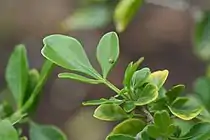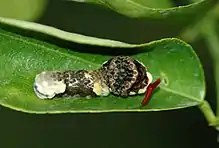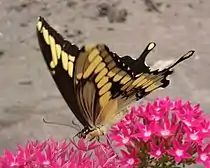Papilio cresphontes
The giant swallowtail (Papilio cresphontes) is the largest butterfly in North America.[2] It is abundant through many parts of eastern North America; populations from western North America and down into Panama are now (as of 2014) considered to belong to a different species, Papilio rumiko.[3] Though it is often valued in gardens for its striking appearance, its larval stage can be a serious pest to citrus farms, which has earned its caterpillars the names orange dog or orange puppy.[4] The giant swallowtail caterpillars possess remarkable camouflage from predators by closely resembling bird droppings. They use this, along with their osmeteria, to defend against predators such as wasps, flies, and vertebrates.[4][5]
| Giant swallowtail | |
|---|---|
 | |
| Scientific classification | |
| Kingdom: | |
| Phylum: | |
| Class: | |
| Order: | |
| Family: | |
| Genus: | |
| Species: | P. cresphontes |
| Binomial name | |
| Papilio cresphontes Cramer, [1777] | |
| Synonyms | |
|
Heraclides oxilus Hübner, [1819] | |
Geographic range
The giant swallowtail is common across the United States, reaching as far north as southern New England and southern Canada. South of the United States, it is found in parts of Mexico and also found in Jamaica and Cuba. The species was historically considered to occur in the western United States and into South America,[4] but now those populations are treated as a separate species, Papilio rumiko, based largely on DNA evidence.[3]
Habitat
In the United States, P. cresphontes mostly inhabit deciduous forest and citrus orchards. They are only capable of overwintering in Florida and the deep South.[2]
Description
One of the giant swallowtail's most notable features is its size. Females have an average wingspan of 5.5 in (14 cm), and up to 6.9 in (18 cm), while males' average is 5.8 in (15 cm), and up to 7.4 in (19 cm).
The wings are black with a horizontal yellow line across the forewings, and a diagonal yellow line across the hindwing. The underside of the wings is yellow with accents of black. A small patch of red on the ventral wing (within the small blue band) allows for distinction from the similar-looking Schaus' swallowtail.[4]
Food resources
Caterpillars
As well as eating valuable citrus crops, larvae eat a wide variety of plants in the family Rutaceae (citrus plants), including different types of prickly ash. They also consume some exotic Rutaceae species that have been introduced to North America, such as gasplant and sapote.
Feeding specialization
In specific local subpopulations (studied in Wisconsin, Ohio, and Florida), it was found that giant swallowtail caterpillars do better on their local host plant than on other giant swallowtail host plants. The local host caused the larva to develop faster than other plants that were also edible to the larva. However, this feeding specialization hypothesis has not been tested in the species as a whole beyond these three regions.[5]
Adults
Nectar plants for adults include Lantana, Azaleas, Bougainvilla, Saponaria officinalis, Hesperis matronalis, Solidago, Lonicera japonica, and Asclepias incarnata.[4] Along with flower nectar, adults can also consume liquid from animal waste.[4]
Life history
Eggs
Females lay eggs on the tops of the leaves of one of their preferred host plants. This is because the first larval instars are unable to move from plant to plant, so the mother must select an appropriate plant to support them. One egg is lain at a time, as opposed to in clutches. The small egg (1–1.5 mm) is brownish colored, but appears more orange due to a special orange colored secretion.[4]
Caterpillars
Once emerged from the eggs, there are five larval instars, wherein the larva grow to about 2 inches before pupating. Larvae are mostly nocturnal, feeding at night. Their appearance changes slightly throughout the instars, with the younger ones having setae and the older instars lacking setae.[4] The caterpillars have remarkable camouflage patterns.[5]
Pupation
Larvae must find a vertical plant, or sometimes a man-made object, to form their chrysalis on, and often they choose the host plant they already occupy.[4] They attach themselves to their substrate of choice and molt to reveal a brown, mottled chrysalis (resembling a bit of dead twig) in which they remain for approximately 10–12 days.
Enemies
Parasites
Giant swallowtails are most vulnerable to parasites when they are in their chrysalis. Common parasites include flies and wasps such as Brachymeria robusta, Pteromalus cassotis, Pteromalus vanessae, and Lespesia rileyi.[4]
Protective coloration and behavior
Larvae have many adaptations to protect themselves from predators.
Coloration
The caterpillars' intricate coloring patterns are an effective camouflage and defense against both vertebrate and invertebrate predators and parasites. It is thought that the coloration was naturally selected for because of its imitation of bird and lizard droppings. The caterpillar mimics certain droppings based on its habitat and which instar it is.[5] The caterpillars' coloration, particularly the saddle pattern, is also thought to be disruptive coloration. This means the coloration makes it harder for a predator to distinguish the shape of the camouflaged prey, which explains the continuation of this coloration pattern in larger instars that are too large to be mistaken for bird droppings.[5] It has also been hypothesized that the older instars' pattern is meant to be reminiscent of a snake.[4]
Other defensive measures
When camouflage is not enough, larvae will employ their osmeteria when they are threatened. The osmeterium is an organ behind the head that “inflates” into an orange/red Y-shaped growth that resembles a snake's forked tongue. By the fourth instar, the osmeterium is more than just a startle mechanism and also has bad-smelling and toxic mixture of acidic chemicals. This is only effective on small invertebrate predators, and the caterpillar will try to rub its osmeterium on the predator to deter it.[4] It has been experimentally tested and found that osmeteria are ineffective at deterring predation from birds.[7]
Physiology
Identifying host plants
Giant swallowtail butterflies must correctly identify their host plants by antennal sensitivity to the specific volatile compounds in the plants. A study found that antennal response to these volatiles depends upon the concentration of the volatiles, the host plant of origin (whether it is a primary or secondary host), and the sex of the butterfly. This last dependency is thought to be because the females, not the males, must identify the correct host plant for egg laying.[8]
Flight
Because of the butterfly's notably large wingspan (14 to 18 cm), giant swallowtails are very strong fliers and are able to glide long distances with very few wing beats.[4]
Interactions with humans
Referred to as "orange dogs" by farmers, the larva targets sweet orange (Citrus × sinensis), causing damage to this valuable produce-bearing plant. The larvae are most detrimental to younger trees, which they can more thoroughly defoliate. Outside of farms, the species is valued for its aesthetic appeal in gardens, and larger trees will not be damaged by larva presence.[4] They can also be raised to butterflies successfully at home.
Control
Biological insecticides, such as Bacillus thuringiensis, as well as chemical insecticides, are used to protect trees against larvae.[4] Methionine, an essential amino acid in humans, has also been found to be an effective killer of caterpillars, with possible use as a nontoxic pesticide against giant swallowtail larvae.[9]
Effects of climate change
There has been a northern expansion of the range of the giant swallowtail in recent years which has been linked to increasingly warm temperatures, and particularly to a lack of September frosts in regions of expansion starting in 2001. Larvae were then able to withstand a few frosts before they pupated. The immediate effects of this warming, as well as their effect on host plants and predators, can explain the giant swallowtail's range expansion.[10]
Gallery
 Egg
Egg P. cresphontes caterpillar showing defensive posture
P. cresphontes caterpillar showing defensive posture Adult, underside
Adult, underside
References
- "Papilio cresphontes - Cramer, 1777 Giant Swallowtail". NatureServe Explorer. NatureServe. 2009-08-19. Retrieved 2010-08-24.
- Fadamiro, Henry; Chen, Li; Akotsen-Mensah, Clement; Setzer, William N. (2010-03-01). "Antennal electrophysiological responses of the giant swallowtail butterfly, Papilio cresphontes, to the essential oils of Zanthoxylum clava-herculis and related plants". Chemoecology. 20 (1): 25–33. doi:10.1007/s00049-009-0039-1. ISSN 0937-7409. S2CID 43390643.
- A new Heraclides swallowtail (Lepidoptera, Papilionidae) from North America is recognized by the pattern on its neck
- "Giant Swallowtail, Orangedog, Papilio cresphontes Cramer (Insecta: Lepidoptera: Papilionidae)1 (PDF Download Available)". ResearchGate. Retrieved 2017-10-22.
- Minno, M. C.; Emmel, T. C. (1992-05-01). "Larval protective coloration in swallowtails from the Florida Keys (Lepidoptera: Papilionidae)". Tropical Lepidoptera Research. 3 (1): 47–49. ISSN 1941-7659.
- "Giant Swallowtail Butterfly (Papilio Cresphontes) | Ninnescah Biology Field Station, Kansas". ninnescahlife.wichita.edu. Retrieved 2017-11-29.
- "CAB Direct". www.cabdirect.org. Retrieved 2017-10-24.
- MI), Scriber, J.M. (Michigan State University, East Lansing; R.V., Dowell (1991). "Host plant suitability and a test of the feeding specialization hypothesis using Papilio cresphontes (Lepidoptera: Papilionidae)". The Great Lakes Entomologist (USA). ISSN 0090-0222.
- Lewis, Delano S.; Cuda, James P.; Stevens, Bruce R. (December 2011). "A novel biorational pesticide: efficacy of methionine against Heraclides (Papilio) cresphontes, a surrogate of the invasive Princeps (Papilio) demoleus (Lepidoptera: Papilionidae)". Journal of Economic Entomology. 104 (6): 1986–1990. doi:10.1603/ec11132. ISSN 0022-0493. PMID 22299361. S2CID 45255198.
- Finkbeiner, Susan D.; Reed, Robert D.; Dirig, Robert; Losey, John E. (2011-07-01). "The Role of Environmental Factors in the Northeastern Range Expansion of Papilio cresphontes Cramer (Papilionidae)". Journal of the Lepidopterists' Society. 65 (2): 119–125. doi:10.18473/lepi.v65i2.a4. ISSN 0024-0966. S2CID 87666043.
- Burris, Judy; Richards, Wayne (2006). The Life Cycle of Butterflies. Storey Publishing. pp. 24–25. ISBN 978-1-58017-617-0.
- Kaufman, Kenn; Eaton, Eric R. (2007). "Swallowtails and Pierids". Kaufman Field Guide to Insects of North America. Houghton Mifflin Books. pp. 230–231. ISBN 978-0-618-15310-7.
- Milne, Margery & Lorus (2005) [1980]. "Butterflies and moths". National Audubon Society Field Guide to North American Insects & Spider (23rd ed.). Alfred A. Knopf, Inc. pp. 719–720. ISBN 978-0-394-50763-7.
- Evans, Arthur V. (2007). "Butterflies and Moths: Order Lepidoptera". Field Guide to Insects and Spider of North America. Sterling Publishing Co., Inc. p. 261. ISBN 978-1-4027-4153-1.
- Kaufman, Kenn; Brock, Jim P. (2003). "Swallowtails and Parnassians". Kaufman Field Guide to Butterflies of North America. Houghton Mifflin Books. pp. 38–39. ISBN 978-0-618-76826-4.
- "Species Detail Butterflies and Moths of North America". Archived from the original on 2010-06-20. Retrieved 2009-01-18.
- "Species Papilio cresphontes - Giant Swallowtail - BugGuide.Net". Retrieved 2009-01-18.
External links
| Wikimedia Commons has media related to Papilio cresphontes. |
| Wikispecies has information related to Papilio cresphontes. |
- Giant swallowtail butterfly life cycle photographs
- Giant Swallowtail on the UF / IFAS Featured Creatures Web site
- Butterflycorner Images from Naturhistorisches Museum Wien
- Giant Swallowtail, Butterflies and Moths of North America
- Papilio cresphontes, funet.fi
- Giant Swallowtail (Papilio cresphontes), CBIF
